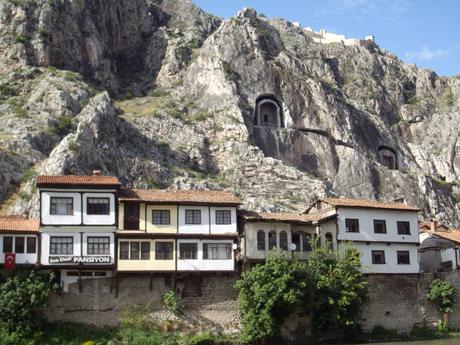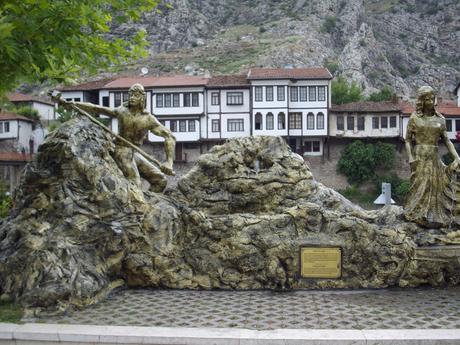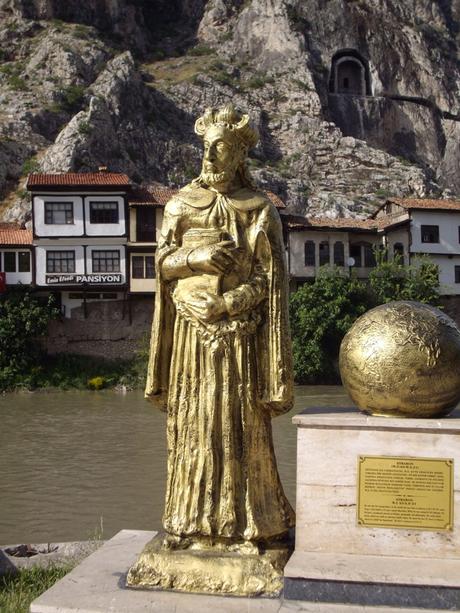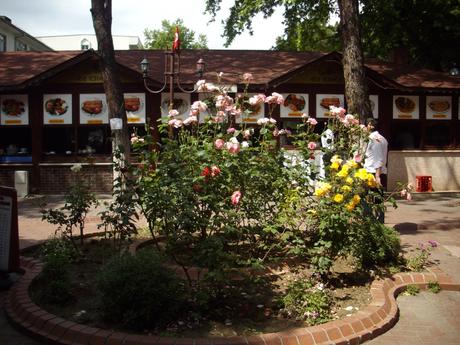As so often happens, it all started with a story. “Have you ever heard the legend of Ferhat and Sirin?” my Turkish friend asked whilst we were discussing some pretty interesting Turkish folklore characters of which there are plenty. “No,” I replied, ear cocked and pen poised, ready to take note of another tale for my growing collection.
“Ah, it’s so sad, sooo romantic,” she sighed being a consummate actress into the bargain. “You see, it all took place in Amasya in the Black Sea region of Turkey.

Amasya
Sirin was a princess and her father, the king, who loved her very much, wanted to build a palace for his darling daughter. Only the best was good enough for her, so he asked the town’s best artist, young Ferhat to do the stone work and decorations. Ferhat and Sirin met, fell hopelessly in love and wanted to marry, a situation the king took a very dim view of. However, moved by his daughter’s pleas, he promised that Ferhat could marry her if he managed to solve Amasya’s big problem: the lack of water. The water was trapped in the surrounding mountains and if Ferhat could manage to open a breach and bring water to the city, his reward would be his beloved Sirin. The king did however impose a harsh condition: Ferhat had to work on his own and he could only use a chisel.
For eleven years Ferhat chipped away, working his way higher and higher up into the mountains, being daily cheered on by Sirin and the entire population for whom he had already become a hero. The day came when the final blow was delivered and the water gushed down into the valley in a wild torrent. Ferhat had turned his back and raised his chisel in triumph when the water swept him down the rocks to his death. In utter despair, Sirin killed herself with a jeweled dagger she carried in her belt. “

Statue to the tragic couple
The story ended in tragedy, but the River Yesil provides Amasaya with water ever since and I had found a new destination to visit.
As I like to do, I traveled by one of Turkey’s comfortable long distance coaches from the Aegean coast to the Black Sea which took about 18 hours .Just as the sun was coming up, I was rewarded by a magic sight: the steep mountains surrounding Amasya and the canyon of the river below, with some of the most beautiful Ottoman wooden houses glued to the mountain sides, all of it crowned by the tombs of King Pontus on one side and a mighty castle on the other. I wished I were a painter instead of a photographer!
Amasya’s civilization dates back more than 5500 years when the Hittites first settled there. No less than 11 cultures have passed though since then, Phrygians, Lydian, Persians and Romans among them and they all left their traces. Instead of the planned two days, I stayed four because there is so much to see.
In true glamour granny style, I had chosen a boutique hotel which was located in one of the converted wooden houses, right across the bridge over the river. The hotel was upscale but, surprisingly, the price was not. EUROS 50 per night for a single room with a huge bathroom incl. breakfast was very good value for money.
And then I went to visit the statues of the town’s heroes: Ferhat and Sirin. They stand along the wonderful river promenade together with a bust of the historian Strabo who was born here and many sultans of the Ottoman Empire.

The historian Strabo
Next was a climb up to the castle which is built on five levels and then, along a ridge to the tombs which are lit by night.
Back down in town I found my way to the archaeological museum and discovered a world famous Hittite statue as well as rare blue-eyed mummies exhibited in a mausoleum in the museum’s ’ garden.
Apart from all the historical sites Amasya has to offer, the place is famous for two other things: the best apples in Turkey and poppies. I sat in a public tea garden and ate what I had found nowhere else in Turkey before: gözleme (paperthin pancakes)covered with a thick paste of poppy seeds. And that resulted in one of the most filling snacks I have ever eaten.

Amasya’s Tea Garden
I needed about an hour’s walk along the river promenade to help it all settle and arrived back in my hotel just as the lights came on and all the statues along the river and the tombs up on the mountain side began to shine. Listening to a legend, I had discovered a true Turkish gem, visited by few tourist or rather only by those ‘in the know’ and thankfully devoid of any the gaudy and garish ‘attractions’ which so often mar the natural beauty of the resorts along the Aegean Sea.

